Craft Traditions – Dog Sledding & Dog Sled Making
Using dogs to pull sleds over snow and ice began in Alaska and Siberia where wintertime lasts most of the year. Special breeds of dogs were raised and trained just for this purpose.
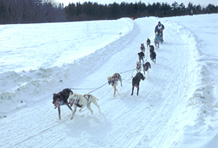
A competitor in the annual
Laconia sled dog race
urges his team over an open trail.
The Alaskan Malamute, originally bred by the indigenous Mahlemiut people of the upper Anvik River, are large and capable of pulling heavy weight over long distances. The Siberian Husky, originally bred by the Chuckchi people of northeastern Siberia, are generally smaller and faster than Malamutes. The people of Siberia used them for a variety of tasks, including herding reindeer and pulling loads on sleds.
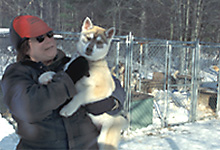
Karen Jones of Tamworth, NH
raises Siberian huskies.
Dog sledding requires three important things-well-fed dogs, well-trained dogs, and good equipment. Dog sledding gained in popularity during the Alaskan gold rush of 1896, which brought prospectors to Alaska. They needed transportation to get into the wilderness and the only way to get there was by dog sled. By the early 1900s, dog sledding, often called mushing, became a common way of traveling during the winter months in many northern expanses of the US and Canada and also grew as a form of recreation.
Mushing comes from the French word "marcher," which means to walk. French prospectors and "voyageurs" who explored and hunted across North America in the mid to late 1800s probably introduced the term. Contrary to popular belief, the word "mush' is not really used as a command for the dogs, as the sound is too soft. Typically, mushers command the team to move with the word "hike."
Sled dog racing began as a formal sport in 1908 with the first "All-Alaska Sweepstakes Race." In the early days, competitive racing provided a good diversion to the difficult living conditions of the northern climates, Though airplanes began replacing sled dog teams for transportation, freight hauling and mail delivery in the 1920s, many people in the north continued to enjoy dog sledding for recreation.
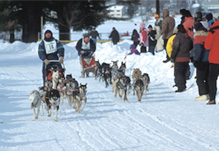
Two dog sled teams approach the
finish line at the annual Laconia race.
In 1925, sled dogs proved their value as a means of transportation when an epidemic of diphtheria threatened the population of Nome, Alaska. The 40 degree below zero weather made air flight impossible. In a heroic team effort, called the "Great Race of Mercy to Nome," twenty mushers and more than 100 dogs ran a grueling relay from Nenana to Nome to deliver a 20lb package of antitoxin serum. The teams covered some 674 miles in less than five and a half days. The Iditarod sled dog race, still run today, commemorates this historic rescue.
By the mid 1900s, sled dogs were being used by explorers to both the North and South poles. New Hampshire's mushers and dog breeders were important to these early explorations. Admiral Byrd appointed Arthur Walden of Tamworth, NH to be the lead driver and dog trainer for his 1929 Antarctic expedition. Walden established a new breed by crossing Greenland Husky, Mastiff, St. Bernard, German Shepherd, and Belgian Sheepdog. Today, the breed caries the name of his lead dog Chinook and they are still popular with mushers.
The design of a dog sled hasn't changed very much over the years. Traditionally they are made from strips of wood lashed together. Today, more modern racing sleds are made from lightweight aluminum and high tech metals.
There are two basic types of dog sleds-basket sleds and toboggan sleds. Basket sleds (sometimes called stanchion sleds) have a seat-called a basket-that is supported by upright stanchions and set 8" to 12" off the runners. This elevation helps to keep the gear or a passenger dry. Basket sleds are fast on glare ice and hard pack trails and in high wind conditions. White ash is the favored wood as it is light and durable.
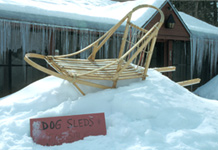
This basket style dog sled was
made by Joel Nordholm.
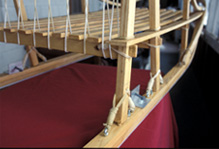
Stanchions are lashed to the basket
and to the runners on the
bottom of the sled.
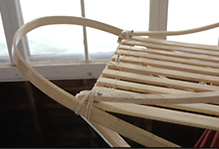
Brushbows are shaped by
heating the wood with steam
to make it pliable
and then held in place
until the wood dries.
Toboggan sleds have a long flat surface area capable of carrying much bigger loads than a basket sled. Today, this platform is usually made from a heavy weight plastic material. They are rigid and durable, and because they ride close to the snow, they are very stable. They can handle soft snow better than a basket sled, but they are also less maneuverable. Both types of sleds have a brush bow in front of the sled to help deflect bushes and small trees.
The musher or driver, stands behind a dog sled and controls the dogs through a set of lines hooked to harnesses on the dogs. The harnesses need to fit each dog correctly, allowing the dog to move easily but fitting close enough to distribute the weight of a heavy load. Each harness is hooked to a gang line, made up of several parts and that allow the musher to control the dogs.
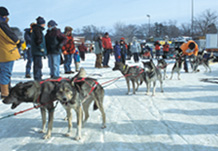
Dog team lining up
to be connected to the gang line.
An essential part of both types of sleds is a brake system, which helps to slow the sled down. The brake system is mounted on the back end of the sled and usually consists of a spring loaded wood plank on one side and a metal plate or hook on the other. When riding the sled, the musher can step down on the brake, driving the plate or hook into the snow to slow the sled down. An essential part of mushing equipment is the snow hook, which is an anchor the musher hooks into the snow when he or she gets off the sled.
New Hampshire has a long history of sled dog racing and a number of traditional dog sled makers. Several major competitions are held annually in New Hampshire and attract people come from across the US and Canada. One of the biggest is held in Laconia and features sprint and short distance runs. There is a 60-mile mid-distance race held in Sandwich where mushers can run the history-filled trails that Walden and other famous drivers ran. Mushers look forward to a cold snowy winter that freezes up the lakes and provides a good snow base for the races. Some years, mother nature provides an abundance of both, and some years she doesn't.
For more information on dog sled making and dog sledding, visit these websites:
Photo credit: Lynn Martin Graton
New Hampshire State Council on the Arts
19 Pillsbury Street - 1st Floor, Concord, NH 03301


